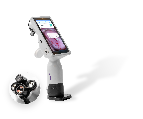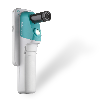SPIE Digital Library. Read Original >
Abstract. A multi-spectral imaging system was built from low cost components: LEDs and an area-scan camera, that are all housed within a case and controlled by a tablet computer. The system can capture images of tissue at 14 different wavelengths in <10 seconds. Spectra derived from different lateral positions in the images were then fit to a theoretical model based on GPU Monte Carlo simulations in order to estimate the scattering and absorption properties of the tissue at different layers. To better characterize the system’s ability to measure changes in tissue oxy- and deoxyhemoglobin content, images of the forearm of healthy volunteers were imaged before, during, and after short term ischemia and then reperfusion of the arm, which lowered the amount of oxyhemoglobin in the tissue. To decrease tissue oxygen saturation, blood flow to the arm was restricted for 120 sec using a sphygmomanometer (blood pressure cuff), with pressure levels of 170 mm Hg. Repeated measurements were captured with the arm held in a special mount with an aperture built to fix the tissue in place.
Overall, the before, during, and after spectra, where there are notable differences between oxy and deoxy-hemoglobin. The analyses showed a significant decrease in oxygen saturation of the venous plexus layer, with moderate changes in blood content. However, changes in the error function were much more sensitive to blood content than oxygen saturation. These results suggest that changes in oxygen saturation levels can be measured using a low cost setup, although at lower accuracy relative to blood content.
Amir S. Bernat, Frank J. Bolton, Kfir Bar-Am, Steven L. Jacques, and David Levitz “Assessing changes in oxygen saturation using a low cost multi-spectral imaging system”, Proc. SPIE 10869, Optics and Biophotonics in Low-Resource Settings V, 1086911 (26 February 2019); doi: 10.1117/12.2511862;https://doi.org/10.1117/12.2511862







